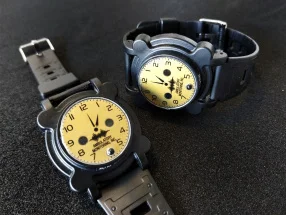How do we measure sleep?
Since our upcoming project is studying the role of sleep in attention development, one of the most important pieces of new equipment in the lab are our sleep actigraphs. These nifty gadgets record movement and when worn through the night, are able to measure the amount and quality of sleep.
The actigraphs that participants will wear
We recently recruited an honorary research assistant to help demonstrate how easy it is to collect the sleep data with the actigraphs and what information can be gleaned from it.
Research Assistant Charlotte inspecting the actigraph before giving it her seal of approval
Using the actigraph is extremely simple. Just put it on the ankle of our infant participants, like you would a watch, and the actigraph will start recording automatically. There are no lights, beeps or buzzes to interfere with regular day-to-day activity and the only input we require is for the grown-ups to note down what time the infants went to bed and got up the next morning.
When the actigraph is brought back to the lab, the data will be downloaded from it and we will be able to chart the sleep patterns, and calculate the quality of sleep.
Charts showing amount of movement during sleep (top), sleep/awake periods (middle), and periods of active sleep phase during the sleep cycle (bottom)
Some of the measures that can be extracted and compared to other participants
One of the aims of the study is to investigate the influence of infant sleep behaviour on attention development in young children and the data collected using the actigraphs is a key component in this. The study hopes to help us better understand attentional disorders such as ADHD and potentially lead to the development of early interventions in the future.




